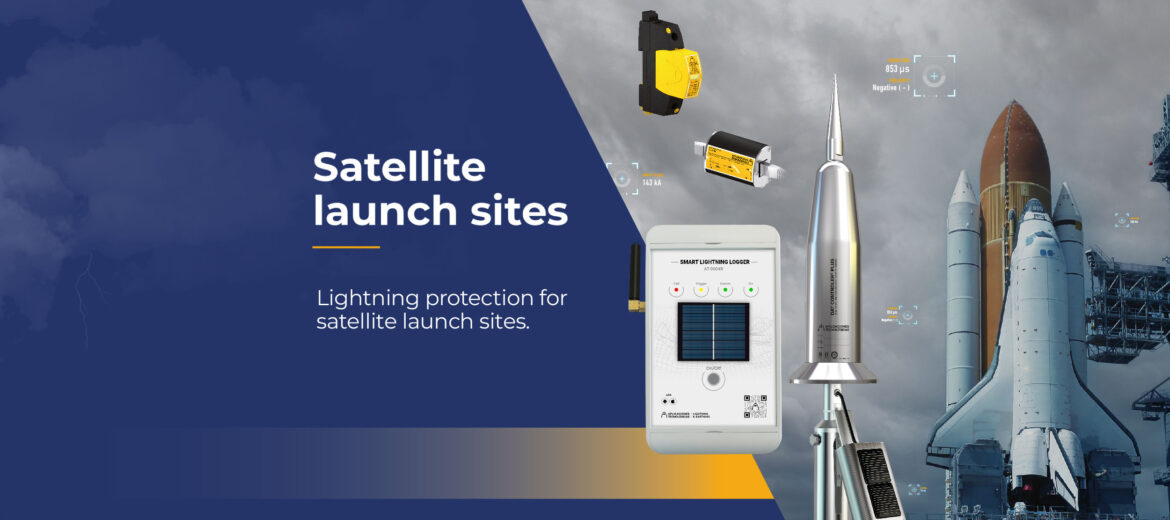Lightning protection of satellite and spacecraft launch platforms is essential. We recently discussed the importance of preventive protection for the authorisation of rocket launches. In this article, we will discuss the engineering of protection against direct or near impacts by means of external and internal protection.
Lightning strikes to unprotected launch sites have led to serious incidents like the activation of sounding rockets and other spacecraft. There have also been events in which impacts have interrupted checks and postponed the launch of spacecraft1.
Nowadays these platforms are used to put essential communication satellites into the orbit. These are complex and high-cost missions that require extensive precautionary measures for their safety and success.
Vehicles designed to carry satellites are usually rockets with control and guidance systems1. These rockets contain oxidising material, fuel and electro-explosive systems (required for self-destruction if necessary). Therefore, when a rocket is on a launch pad, lightning strikes can cause serious accidents, with large losses in terms of human lives, money and time. Moreover, digital systems are being increasingly used for flight control and instrumentation, instead of analogue and mechanic ones. This increases the vulnerability of vehicle to the effects of lightning strikes1,2.
Lightning also poses a threat to electrical data lines, and could cause uncontrolled ignition of fuel1. In addition, hazards associated with lightning are significant in all phases of launch operations, which are often conducted in the open air3.
A direct hit to a spacecraft might cause local damage to the thermal insulation of this spacecraft. In the event of a large lightning current and a possibility of significant direct currents, structural damage to a spacecraft cannot be excluded. Therefore, after an impact, the damage assessment is required1.
Launching pads are prone to lightning strikes as isolated structures with heights of 60-100 metres located on flat terrain. Also, most of these sites are located in areas of high isoceraunic level and close to coastal regions where lightning activity is higher1.
In fact, NASA’s launch complex 39A has received an annual average of 3 impacts since 19794. In 1998, the platforms 39A and 39B received at least 5 impacts with a space shuttle installed on them. However, their equipment was not damaged thanks to the lightning protection installed. Moreover, in 1983, impacts occurred before three of the four shuttle launches5.
Therefore, aerospace vehicles, flight hardware, ground support equipment, and all facilities where potentially hazardous tests or operations are performed must be adequately protected against lightning6.
According to Cooray1, the philosophy behind lightning protection of satellite launch sites and vehicles involves a three-level defence:
– First, meet NASA’s launch criteria (Lightning Launch Commit Criteria, LLCC).
– Second, use a suitable lightning protection system (LPS) to protect the platform from hazardous impacts.
– Finally, use electromagnetic shielding techniques to protect systems inside a vehicle and launch systems.
Further details of some strategies followed in the aerospace industry for lightning protection of satellite launch sites are presented below.
Satellite launch sites: external lightning protection
External protection has the function of intercepting lightning and minimising the effects of a lightning current passing to an earthing system. Launch pads usually employ traditional lightning protection.
However, external protection of launch pads is challenging due to their height and size. Protection in strict accordance with conventional protection standards such as IEC 623057 is highly complicated. Early Streamer Emission devices (ESE air terminals) provide a larger area of protection, as they emit the continuous upward tracer before any other object within their protection radius.
Satellite launch sites: internal lightning protection
Lightning strikes produce a high-velocity magnetic field which induces high voltages in conductors in surrounding area. Resonant electrical effects of protective cables and structure can also contribute to high induced voltages3.
In addition, a payload of a satellite typically consists of electronic equipment sensitive to transient surges. Therefore, in the event of a lightning strike while a vehicle is on a platform, appropriate checks should be carried out to confirm that no damage has occurred3.
As a result, lightning protection zones (LPZ, or zones in which an electromagnetic lightning environment is defined8) must be determined in the early stages of vehicle design, because they depend on the geometry and covering of a spacecraft6.
Thus, the internal protection of launch sites and spacecrafts is implemented through the spacecraft structure as well as through equipotential bonding and cable shielding1.
The equipotential bonding of all electrical components (connections, metallic pipes, etc.) makes it possible to achieve an equipotential bonding area. This is especially relevant where critical electronic components are located1.
For example, all tank sections must be welded and connected to achieve a low-impedance reference plane. Similarly, all metal parts larger than 30 centimetres must have a discharge path to the structure1.
Moreover, when a vehicle is on a platform, electrical continuity to the earthing between the two must be ensured during all stages of a grounding operation6.
In line with the principles of lightning protection applicable to other installations, equipotential bonding must have an adequate cross-section; connection points must be free of any insulating and foreign material such as paint, rust and corrosion1.
For electrical cables, general electromagnetic shielding guidelines should be followed to limit the level of noise or interference throughout a system. Also, where possible, e.g. for control and data transmission, it is preferable to use fibre optic cables1.
Surge protection devices (SPD) should be located at critical circuit interfaces and in current loop areas where potential differences can be significant during direct or near hits1.
Aplicaciones Tecnológicas: the added value of smart technology for lightning protection
Aplicaciones Tecnológicas S.A. has been offering the most advanced solutions for security against electrical storms for more than 35 years. Our catalogue includes:
– The smart early warning system against the risk of thunderstorms ATSTORM®. This system assesses the risk of thunderstorms using local sensors, IoT technology and expert algorithms.
– The smart lightning arrester DAT CONTROLER® REMOTE Early Streamer Emission device has a technology that extends the protected area compared to conventional external protection. In addition, it performs self-diagnostics and communicates the lightning rod’s status on a daily basis via IoT connection.
– SMART LIGHTNING LOGGER is a smart system that alerts and registers lightning strikes in real-time. This counter monitors the activity in the down conductor of a lightning rod, providing information on each discharge at the moment of impact. The lightning parameters measured by devices such as the SMART LIGHTNING LOGGER make it possible to assess the possible effects of lightning strikes on sensitive electronic equipment. Real-time monitoring and communication make the whole process much faster3.
On the other hand, in Aplicaciones Tecnológicas S.A. we have surge protection devices, including surge counters, exothermic welding (also called aluminothermic) APLIWELD® Secure+, lightning arresters and accessories as well as earthing materials.
For information about Aplicaciones Tecnológicas S.A.’s technological range of products and services for thunderstorm safety, please contact our experts at the following link.
References
- Cooray, V. Lightning Protection. (The Institution of Engineering and Technology, 2010).
- Harms, D. E., Boyd, B. F., Flinn, F. C. & McNamara, T. M. Weather system upgrades to support space launch at the eastern range and the Kennedy Space Center. Weather 50, (2003).
- Colon, Jose L. Lightning Protection and instrumentation at Kennedy Space Center. in Third LACCEI Internattonal Latin American and Caribbean Conference for Engineering and Technology (LACCET’2005) (2005).
- Stahmann, J. R. Launch pad lightning protection effectiveness. in vol. 1 12 (1991).
- NASA Facts AC 321/867-2468. Lightning and the Space Program. http://www.tstorm.com/images/lightning_space_program.pdf (1998).
- Goodloe, C.C. Lightning Protection Guidelines for Aerospace Vehicles. https://ntrs.nasa.gov/api/citations/20000004589/downloads/20000004589.pdf (1999).
- International Electrotechnical Commission (IEC). IEC 62305-1 Protection against lightning – Part 1: General principles. (2010).
- International Electrotechnical Commission (IEC). IEC 62305-4 Protection against lightning – Part 4: Electrical and electronic systems within structures. (2010).



